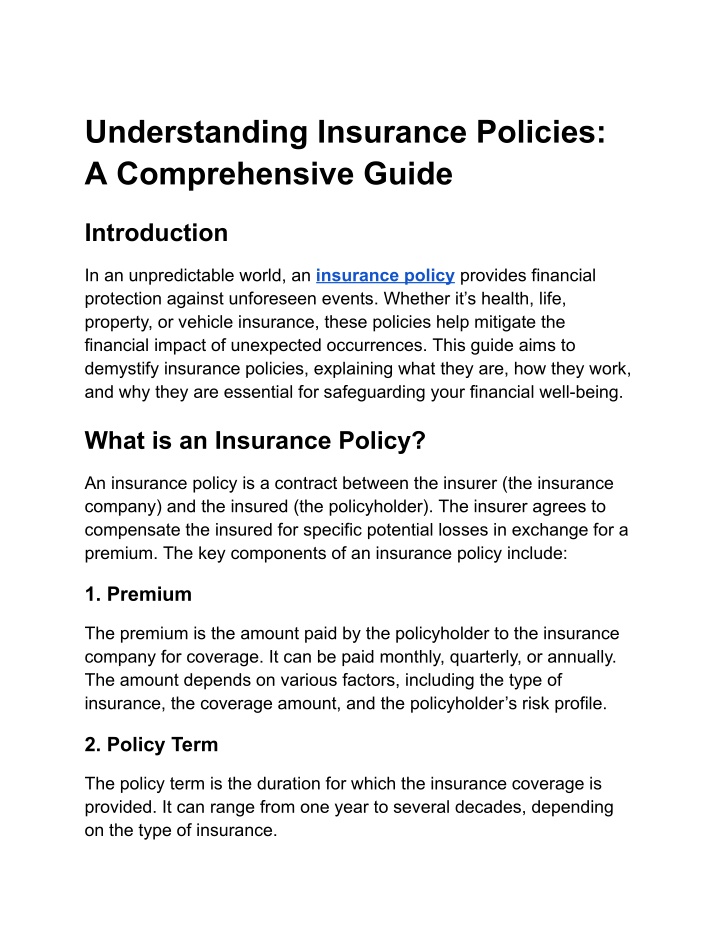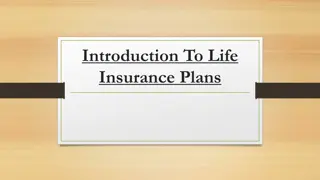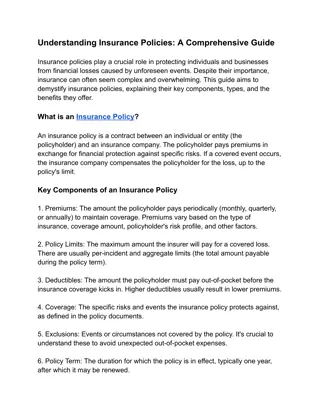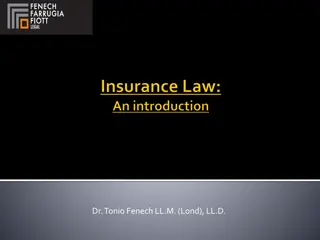
Understanding Insurance Policies_ A Comprehensive Guide (7)
In an unpredictable world, an insurance policy provides financial protection against unforeseen events. Whether itu2019s health, life, property, or vehicle insurance, these policies help mitigate the financial impact of unexpected occurrences. This guide aims to demystify insurance policies, explaining what they are, how they work, and why they are essential for safeguarding your financial well-being.
Uploaded on | 3 Views
Download Presentation

Please find below an Image/Link to download the presentation.
The content on the website is provided AS IS for your information and personal use only. It may not be sold, licensed, or shared on other websites without obtaining consent from the author. If you encounter any issues during the download, it is possible that the publisher has removed the file from their server.
You are allowed to download the files provided on this website for personal or commercial use, subject to the condition that they are used lawfully. All files are the property of their respective owners.
The content on the website is provided AS IS for your information and personal use only. It may not be sold, licensed, or shared on other websites without obtaining consent from the author.
E N D
Presentation Transcript
Understanding Insurance Policies: A Comprehensive Guide Introduction In an unpredictable world, an insurance policy provides financial protection against unforeseen events. Whether it s health, life, property, or vehicle insurance, these policies help mitigate the financial impact of unexpected occurrences. This guide aims to demystify insurance policies, explaining what they are, how they work, and why they are essential for safeguarding your financial well-being. What is an Insurance Policy? An insurance policy is a contract between the insurer (the insurance company) and the insured (the policyholder). The insurer agrees to compensate the insured for specific potential losses in exchange for a premium. The key components of an insurance policy include: 1. Premium The premium is the amount paid by the policyholder to the insurance company for coverage. It can be paid monthly, quarterly, or annually. The amount depends on various factors, including the type of insurance, the coverage amount, and the policyholder s risk profile. 2. Policy Term The policy term is the duration for which the insurance coverage is provided. It can range from one year to several decades, depending on the type of insurance.
3. Coverage Coverage refers to the scope of protection provided by the insurance policy. It outlines the specific risks or events that the insurer will cover, such as medical expenses, property damage, or loss of life. 4. Deductible A deductible is the amount the policyholder must pay out-of-pocket before the insurance company pays a claim. Higher deductibles usually result in lower premiums and vice versa. 5. Exclusions Exclusions are specific conditions or circumstances that the insurance policy does not cover. It s crucial to understand the exclusions to know what is not covered under the policy. Types of Insurance Policies There are various types of insurance policies designed to cover different aspects of life and assets. Here are some of the most common types: 1. Health Insurance Health insurance covers medical expenses incurred due to illnesses or injuries. It can include coverage for hospitalization, doctor visits, prescription medications, and preventive care. Health insurance is vital to protect against high medical costs.
2. Life Insurance Life insurance provides financial security to the policyholder s beneficiaries in the event of the policyholder s death. There are two main types: Term Life Insurance: Provides coverage for a specific term, usually ranging from 10 to 30 years. It pays a death benefit if the policyholder dies during the term. Whole Life Insurance: Offers lifelong coverage and includes an investment component known as cash value, which grows over time. 3. Auto Insurance Auto insurance covers damages and losses related to vehicles. It typically includes: Liability Coverage: Covers damages to other people or property caused by the policyholder s vehicle. Collision Coverage: Covers damages to the policyholder s vehicle resulting from a collision. Comprehensive Coverage: Covers damages to the policyholder s vehicle from non-collision events, such as theft, fire, or natural disasters. 4. Homeowners Insurance Homeowners insurance provides protection for your home and personal belongings against risks such as fire, theft, and natural disasters. It also includes liability coverage for accidents that occur on the property.
5. Disability Insurance Disability insurance provides income replacement if the policyholder is unable to work due to a disability. It ensures financial stability during periods when the policyholder cannot earn an income. Benefits of Having an Insurance Policy Having an insurance policy offers several significant benefits: 1. Financial Security Insurance policies provide a safety net that ensures financial stability in the face of unexpected events. They help cover substantial expenses, reducing the financial burden on the policyholder and their family. 2. Peace of Mind Knowing that you are protected against potential risks brings peace of mind. Insurance allows you to focus on your personal and professional life without constantly worrying about unforeseen financial setbacks. 3. Legal Protection Certain types of insurance, such as auto and professional liability insurance, are legally required. Having these policies ensures compliance with the law and protects against legal penalties. 4. Risk Management Insurance policies help manage risks effectively by transferring the financial burden of losses to the insurance company. This allows individuals and businesses to recover quickly and continue their operations smoothly.
Choosing the Right Insurance Policy Selecting the right insurance policy involves careful consideration of several factors: 1. Assess Your Needs Identify the risks you want to protect against and determine the appropriate coverage amount. Consider your financial situation, assets, and dependents to choose a policy that provides adequate protection. 2. Compare Policies Compare different policies from various insurers to find the best coverage at a reasonable premium. Look for policy features, coverage limits, deductibles, and exclusions. 3. Check Insurer s Reputation Research the insurance company s reputation, financial stability, and customer service record. Choose an insurer with a strong track record of prompt and fair claim settlements. 4. Read the Fine Print Carefully read the policy documents to understand the terms and conditions, coverage details, and exclusions. Ask questions and seek clarification if anything is unclear.
Conclusion An insurance policy is a crucial tool for financial protection and risk management. By understanding the different types of insurance, their benefits, and how to choose the right policy, you can ensure that you and your loved ones are well-protected against life s uncertainties. Investing in the right insurance policy today can provide peace of mind and financial stability for the future.






















